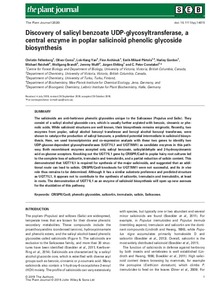Discovery of salicyl benzoate UDP-glycosyltransferase, a central enzyme in poplar salicinoid phenolic glycoside biosynthesis
Christin Fellenberg; Oliver Corea; Lok-Hang Yan; Finn Archinuk; Eerik-Mikael Piirtola; Harley Gordon; Michael Reichelt; Wolfgang Brandt; Jeremy Wulff; Jürgen Ehlting; C. Peter Constabel
Discovery of salicyl benzoate UDP-glycosyltransferase, a central enzyme in poplar salicinoid phenolic glycoside biosynthesis
Christin Fellenberg
Oliver Corea
Lok-Hang Yan
Finn Archinuk
Eerik-Mikael Piirtola
Harley Gordon
Michael Reichelt
Wolfgang Brandt
Jeremy Wulff
Jürgen Ehlting
C. Peter Constabel
WILEY
Julkaisun pysyvä osoite on:
https://urn.fi/URN:NBN:fi-fe2021042824127
https://urn.fi/URN:NBN:fi-fe2021042824127
Tiivistelmä
The salicinoids are anti-herbivore phenolic glycosides unique to the Salicaceae (Populus and Salix). They consist of a salicyl alcohol glucoside core, which is usually further acylated with benzoic, cinnamic or phenolic acids. While salicinoid structures are well known, their biosynthesis remains enigmatic. Recently, two enzymes from poplar, salicyl alcohol benzoyl transferase and benzyl alcohol benzoyl transferase, were shown to catalyze the production of salicyl benzoate, a predicted potential intermediate in salicinoid biosynthesis. Here, we used transcriptomics and co-expression analysis with these two genes to identify two UDP-glucose-dependent glycosyltransferases (UGT71L1 and UGT78M1) as candidate enzymes in this pathway. Both recombinant enzymes accepted only salicyl benzoate, salicylaldehyde and 2-hydroxycinnamic acid as glucose acceptors. Knocking out the UGT71L1 gene by CRISPR/Cas9 in poplar hairy root cultures led to the complete loss of salicortin, tremulacin and tremuloidin, and a partial reduction of salicin content. This demonstrated that UGT71L1 is required for synthesis of the major salicinoids, and suggested that an additional route can lead to salicin. CRISPR/Cas9 knockouts for UGT78M1 were not successful, and its in vivo role thus remains to be determined. Although it has a similar substrate preference and predicted structure as UGT71L1, it appears not to contribute to the synthesis of salicortin, tremulacin and tremuloidin, at least in roots. The demonstration of UGT71L1 as an enzyme of salicinoid biosynthesis will open up new avenues for the elucidation of this pathway.
Kokoelmat
- Rinnakkaistallenteet [27094]
